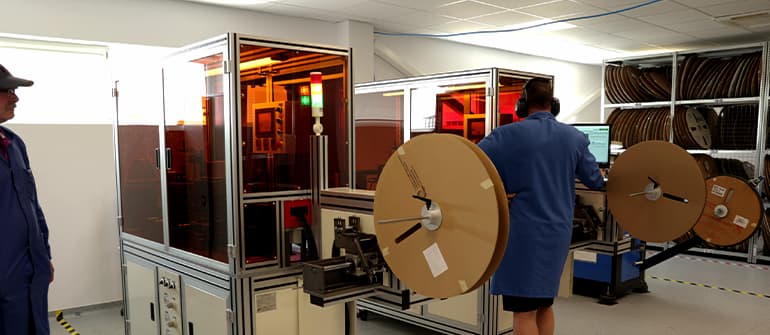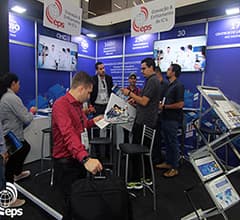Home > News & Blog > Component Packaging for the Assembly Line
The Challenges of Component Packaging for the Assembly Line
The Advantages of Tape and Reel

The global component packaging market is majorly driven by the rising manufacturing activities in consumer electronics, automotive, healthcare and industrial automation sectors. In addition, rising automation in manufacturing processes have also added to the demand for the efficient packaging of components. Component packaging plays a critical role in the success of volume manufacturing in factories that operate automated assembly processes, including surface main technology or SMT.
The efficiency, speed, throughput and ultimate profitability of a production line depends on the parts being presented consistently and in the right orientation, ready for automated pick and place operations on the line.
To facilitate the storage, transport and assembly of electronic and electromechanical components in manufacturing, they are often packaged into individual pockets within carrier tape. The tape is wound around a reel and can be loaded onto automatic placement machines used on production lines. The process is known as tape and reel.
Tape and reeling is the most reliable and consistent packaging solution for modern manufacturing environments, providing a streamlined, efficient and secure method for handling and placing small electronic components. Tape is customized to fit the exact dimensions and protective needs of specific components and also provides protection to integrated circuits and other non-electronic devices from physical and electrostatic discharge (ESD) damage during shipping and storage.
My name is Ciara McCarthy, I'm the CMO at EPS Global, and today I have the pleasure of speaking to Dean LoPresti, who heads up our business development activities for manufacturer support services in North America.
Dean has been in the industry for quite some time and can speak to the challenges of component packaging for the assembly line.
What obstacles do manufacturers encounter when packaging components for products assembled on production lines?
One of the biggest challenges they have is speed. Today’s assembly machines can place thousands of components per hour on a circuit board. To achieve this speed, the component delivery system needs to be able to feed parts at high speed with consistent orientation and part spacing. When parts aren't on tape and reel, if they arrive to the assembly line in a different package it is much slower. Tape and reel is the fastest and preferred packaging any of our customers in the industry can use for assembling products on the production line.
Previously, a lot of this process took place by hand, but nobody wants this anymore, the components are really sensitive and small, so having things on tape and reel is always going to be optimal for efficiency and quality.
The other issue they have is real estate – space on the line. Tray feeders take up more space than reels. Space costs money in reality as if you can have more parts being presented to the line on reels (taking up less space than the trays), you can increase throughput, productivity and yield therefore increasing revenue.
Ciara: I also imagine removing humans from the equation reduces the points of failure?
Dean: Exactly, quality is key, quality is built into what we try to do every day.
Could you provide us with a high-level explanation of what Tape and Reeling is?
One way to think about Tape and Reel is to think of an old film company where they have a big reel with the film on it.
Tape and Reel looks similar. It's a 13” or 15” reel, on which there is a tape. The difference is, we're not watching a movie, and what's in the tape are components! Many different components can be inside the tape, but essentially that is what tape and reel is.
It's a tape wound around a reel, and then the reel is sent to the OEM or Contract Manufacturer's factory line ready for automated pick-and-place processes in manufacturing.
Ciara: That's a good analogy, I can imagine the movie reel.
Why might a customer prefer to have their components supplied in tape and reel packaging?
Take contract manufacturing for example. The main reason they would want them on tape and reel is that putting a reel on a machine on a line is going to give you the highest output.
You can use trays; you can use bulk feeders; cut pieces of tape; but in the end using tape and reel is the fastest. Also, when it comes to delivery, parts are more secure if you're shipping on tape and reel.
Nowadays, distribution plays a crucial role in supplying components across various situations, generating significant business for us. This is primarily because distributors often struggle to provide parts on tape and reel, and manufacturers may also be reluctant to do so.
Therefore, offering parts on tape and reel emerges as the optimal solution. Many of our clients prefer to send us their components for us to place them on tape and reel, as efficiency is paramount for all our customers.
Tape and Reel packaging also protects the components from damage during shipping, handling, and assembly.
Could you describe the complete Tape & Reel process, starting from the moment a device is received at one of our service centers, through its placement on the tape and reel, and up until it is dispatched to the manufacturing facility?
Firstly, the most crucial piece of information we need is the part number, which determines the package type. Upon receiving the part number, our nearest engineering team will verify if a standard carrier tape is available for it.
If a standard tape is available, we will initiate the setup process. We will provide the customer with a form asking them to specify details such as the orientation of pin one, the number of parts per reel, and other preferences. Once we receive the parts from the customer, a work order will be generated, printed, and sent to the production floor. The pre-selected carrier tape and any customizations will be loaded onto a machine with an operator. The parts will then be transferred from tubes to the tape and reel using automatic machinery wherever possible.
So to summarize, the process is simple, the customer sends us the specifications, we prepare the setup process in advance, we receive the parts from our customer, we put things on standard tape and reel (in most cases it's a 15” reel), we wrap them up, perform inspections before placing them in an ESD or a dry pack bag, and send them out to the customer.
The key to the process is the homework we do before we start a job with the customer.
Is the tape and reel process exclusively used for electronic components?
No, we do tape and reel a lot of electronic components but it’s not for printed circuit board assembly exclusively, we can also tape & reel components like electromechanical and mechanical parts like connectors, diodes, capacitors, heatsinks that go into power tools, sheet metal parts, injection molded parts, the list goes on… You’ll remember we’ve even tape & reeled candy to give out at trade shows in the past! I will go out there and say almost anything can be put on tape and reel if the customer really wants us to do it. The limiting factor is size but for cases that step outside the standard sizes, we offer custom tape manufacture.
Standard tape sizes can go from 8mm, 12mm, 16mm, 24mm, 32mm, 44mm, 52 millimeter and up to 84mm.
The customer needs to specify the A0, the B0 and the K0 dimensions, that's simply height, width, and depth respectively.
We can put connectors on tape and reel, we can put metal flakes, some really tiny parts on tape and reel. On the other end of the scale – we can even tape and reel big bulky connectors, such as a 20-pin connector. That's what our job is, accommodating what our customers require. If we receive a request for something unusual to be placed on tape and reel, our first response is usually – “wow, that's going to be fun to put on tape and reel!”, but we have a great team and they'll design pockets based on drawings and come up with what works for the customer.
Ciara: To follow on from this...
What's the strangest or most peculiar item you've ever placed on a tape and reel?
Great question. We get a lot of calls on, “Can you put this on tape and reel?”, and our team is great at giving the customer what they need as strange as it may be.
So things like pins, skinny pin connectors, deep pockets, you got to stay within the industry standards, but it can be done once you determine the size of the pocket. Things are getting small these days, We’ve a job on at the moment, this is pretty unusual, or at least interesting - we are currently tape and reeling small PCBs, roughly 1” x 1”. We got a request in, and we worked with the customer to create custom tape to accommodate the PCB. The customer was ecstatic about it as they hadn’t been able to find a service provider who could do this before. It’s actually one of our global customers that we deal with in a number of locations around the world. They’ve been pretty happy about how we’ve been able to put the PCBs into tape, ready for their manufacturing process, but once we had the specs, we did it pretty easily.
So packaging a PCB is a type of request we’re starting to get more and more frequently, they can be as small as 0.5 inch2 , sometimes smaller, sometimes larger, but a lot of times squares and rectangles. We get also requests to tape and reel wafers or other tiny devices.
Ciara: That’s amazing, you're putting an entire PCB into the carrier tape.
Dean: That's probably the most interesting, but we get a lot of interesting enquiries.
What's the smallest components that you have tape and reeled?
We’ve gotten requests to tape and reel some tiny and complex devices, so small you could put thousands in the palm of your hand! We regularly tape and reel parts that are 6mm x 2mm and 1mm x 2mm which are very small in all dimensions, but we've got a lot of automated equipment with inspection systems to handle them. Once you’ve completed the job once, you have the process in place. We also create the tape for these components too.
Ciara: So you're talking about offering custom or tailored solutions based on a device size or shape if it does not adhere to the normal standard tape widths.
What is custom tape manufacturing?
We offer tape & reel packaging solutions for parts that might not fit conventional carrier tapes. For those, we manufacture custom carrier tape… the embossing of tape to match dimensions specified in customer drawings. Like before, it all starts with the part number, even if it's a non-custom part, it's still going to have a part number, and what's key is the dimensions. Once we’ve checked our database, if a standard carrier tape isn’t available, we'll require a technical drawing of the part from the customer. We take this drawing and then the team will come up with the first 2D drawing of the carrier tape so we can develop the tooling that’s need to emboss the pockets in the flat carrier tape.
After this, we go back and forth with the customer to decide the important aspects of the custom tape, the A0, the B0 and the K0 dimensions; the pitch; the pitches from center to center of each component; the type of material for the carry tape; the type of cover tape; those are all essential items to cover in advance of starting the process.
Once all this criteria is approved by the customer, we'll send them a sample of the tape, then end them a sample of their parts in the tape. Once they’re happy with everything we're off to the races (so to speak), taping as fast as they need us to go.
What factors should manufacturers consider when selecting the carrier tape and cover tape?
Carrier tape can be made from a couple of different materials, it can be clear; it can be ESD; it can be non-ESD; we need to know these things up front, we can essentially make them all as we use a raw material at first to form the tapes.
Regarding the carrier tape, it is vital to know the width in advance. Our customers are going to have feeders for their lines, the feeders are the same dimensions that I mentioned earlier, 8mm, 12mm, 16mm, 24mm, so we'll need to match the tape up with their feeders. EIA-481 is the standard for tape and reel, and we follow the standards set by the Electronics Industries Alliance.
When it comes to custom tape, customers are going to have to tell us what they need as it goes outside this standard.
Additionally, knowing the orientation of pin 1 is vital. The pick and place machines are going to pick it up and adjust it within a 360° range and it needs to know where pin 1 is so that the customer can program their machine to specify how much it needs to turn the component before it goes on the board.
Ciara: I can imagine how important it is for high-volume production to have the parts consistently delivered or positioned within the tape, so that the pick and place machines are ready to go.
How do the services such as Component Programming and 3D Inspection contribute to improving the value chain?
Outside of standalone taping and reeling, almost everything we do in EPS Global - IC Programming, Embedded Security, Component Baking, Component Pre-forming, ends up with the components being placed on Tape and Reel so they’re ready for the next process in manufacturing which is usually the SMT process on an assembly line. Another key service we also provide is Coplanarity checking and 3D inspection of the parts that go on tape and reel, to ensure they’re in the correct orientation and free from defects to reduce any issues on the production line. The last thing you want is delays or line stoppages.
Also, a part of tape and reel that doesn’t get mentioned too often but should be is the inspections we perform on each job that we do. After the parts go into the tape and reel, we use a mix of automated and manual inspection protocols for example to make sure that everything is just how it should be and ready for the factory floor.
Ciara: We often get requests about cut tape and reel; or tape splicing.
What is cut tape and reel?
When a particular part is in short supply, our customers may have to visit several different distributors to get the quantity they require, which means that they could end up with 20 parts on a small piece of tape from the first distributor, 108 from the second, 45 from the third, and so on.
Our job is to gather these cut tape segments and either repackage them onto a reel or attach splicers to the tape to form one continuous reel.
Does EPS Global provide different options for pin 1 placement on tape and reel?
If a customer is uncertain about what they need, the default position for pin 1 is the top left corner. For rectangular components, the identification can be made at the top left and bottom right corners. In the case of square components, identification points can be established at all four corners: top left, top right, bottom left, and bottom right, and if it's a non-standard part, the customer would just have to let us know.
What would be considered normal turnaround for Tape and Reel orders?
In EPS Global service centers around the world, the standard turnaround time for tape and reel orders typically ranges from three to five days, with most instances concluding around the four-day mark. However, this can vary depending on the volume of work, as many tasks involve handling high volumes. Despite this, there is flexibility to accommodate partial shipments and begin dispatching items immediately, if necessary. Nevertheless, the usual turnaround time remains between three to five days, emphasizing a consistent expectation for delivery timelines. This is not the case with other service providers. Customers come to us because they’re unhappy with the turnaround times or service levels they’re getting from their existing partner.
Does EPS Global offer expedited tape and reel services?
Yes, all of our facilities are equipped with programming machines that handle both tape and reel, in addition to a significant number of standalone machines dedicated solely to tape and reel. We offer expedited services for those in need of quicker turnarounds, but there's an additional cost to it. But with our great customer service teams globally, ask for an expedited service, you'll get a quote, we'll get it done.
Ciara: So you’ve explained how Custom Tape differs from the standard carrier tape.
What is the typical processing time for a customized carrier tape?
We've truly set ourselves apart in the industry with our performance. Typically, the normal turnaround time is 4 weeks, but there's always the option to request an expedited service, reducing this period to just 2 weeks. While we consistently quote a 4-week timeframe, our track record shows that we often exceed expectations. For instance, from the moment an agreement on a carrier tape is reached, we're capable of supplying a customer with a new 22" reel of the carrier tape within just 10 days. However, in scenarios where new tools need to be created, the maximum time required will be 4 weeks.
Glossary of Terms
- Tape and Reel: A packaging method where components are placed in the pockets of a carrier tape, which is then wound around a reel for efficient handling and assembly.
- Carrier Tape: A continuous strip of material with pockets designed to hold individual components securely during storage, transport, and assembly, as specified by EIA-481.
- Custom Carrier Tape: Carrier tape that is specifically designed and manufactured to fit the unique dimensions of non-standard components.
- 3D Inspection: A quality control process that uses 3D imaging technology to inspect components for defects or inaccuracies before and after packaging.
- Cut Tape: A segment of carrier tape that contains a small quantity of components, typically resulting from partial use or distribution in smaller quantities.
- Splicing: The process of connecting segments of cut tape to form a continuous strip, allowing for efficient automated assembly.
- Surface Mount Technology (SMT): A method for producing electronic circuits in which components are mounted directly onto the surface of PCBs.
- Component Programming: The process of loading software or firmware into integrated circuits (ICs) before they are assembled onto a printed circuit board (PCB).
- Electrostatic Discharge (ESD) Damage: Damage caused to electronic components by the sudden flow of electricity between two electrically charged objects.
- Embedded Security: Security features that are built into components at the programming stage to protect against unauthorized access and tampering.
- Integrated Circuits (ICs): Electronic circuits that combine multiple electronic components into a single chip.
- Pin 1 Orientation: The specification of the location of the first pin of a component, crucial for correct placement and functionality in the assembly process.
- PCBs: Printed Circuit Boards. Used in electronics to mechanically support and electrically connect electronic components using conductive pathways.











